Meet the blob, a living anomaly
It has no brain, but it learns. No mouth, but it digests. No evil plan (yet), but it spreads, survives, repairs itself, and clones itself. If you think you’re dealing with a simple, lazy puddle of DNA, think again.
It is, in itself, a sticky finger stretched out toward the classic definitions of biology.
Here are 5 of its most disturbing talents!
⌚ Reading time: 5 min
Sprawling cell
Find the blobs!
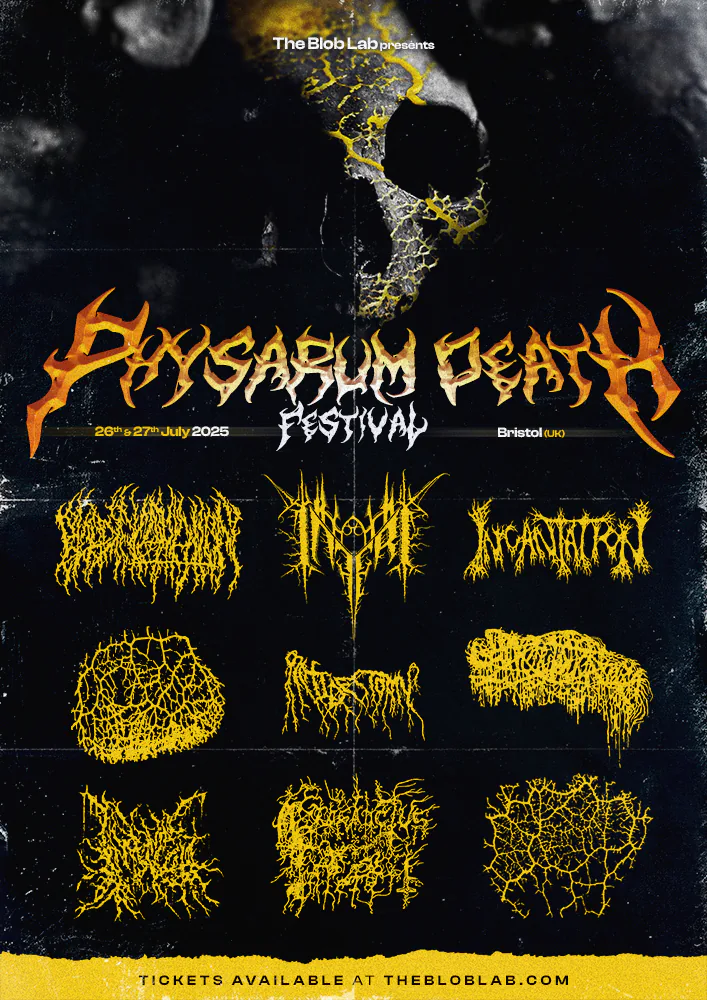
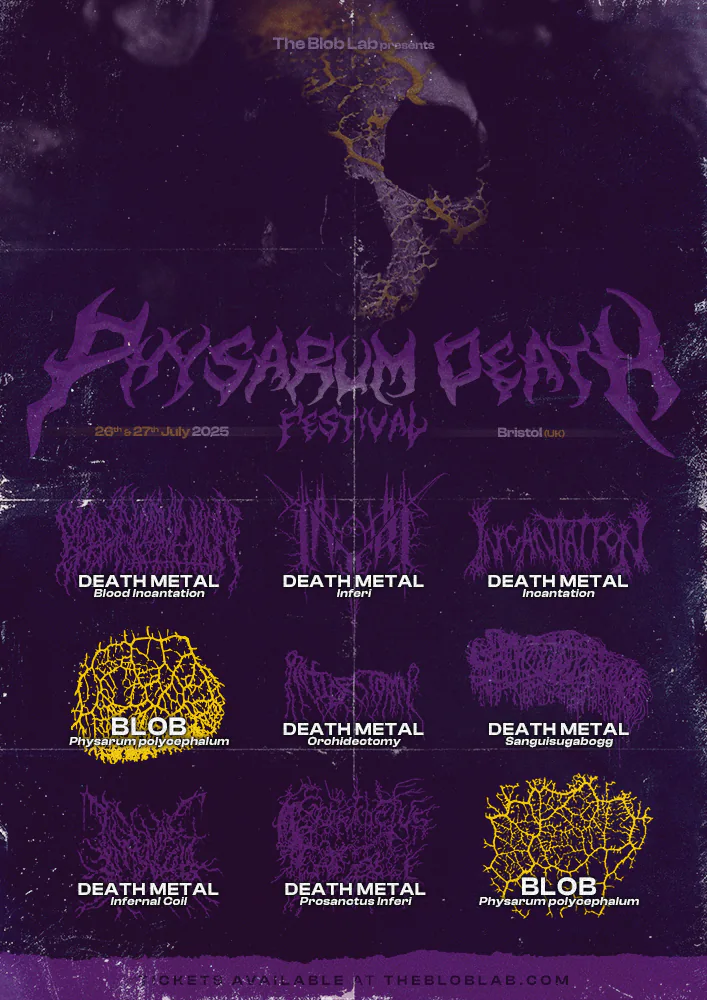
Confusing blobs with death metal: a classic mistake made by unwary biologists. The only way to tell the difference between a death metal band and a blob is to remove the yellow filter.
Draw a circle, fill it with water, add a dash of yellow: just a few details apart, and you have a blob.
Don’t be fooled by this pompous tree-like display: the blob is in fact a single cell.
Yes, just one. Neither a patchwork of small units nor a well-organized collective. One. Single. Large. Cell.
Nothing like the boring, neatly spherical model in biology textbooks.
Here, you’re dealing with a sprawling supercell, capable of extending over several square meters while maintaining the same basic structure.
Inside? Zero partitions, zero internal membranes.
No boundaries.
Just a huge interconnected network: an open system where everything communicates in real time. Nutrients, signals, organelles – everything circulates in the large cytoplasmic bath, propelled at a steady pace by its own mechanism.
🎬 Blobbuster of the 1950s
Blob, did you say Blob?
A name straight out of an old cult horror movie: The Blob (1958).
A slimy, cunning, voracious monster… and charismatic enough to inspire scientists.
Since then, the word has come to refer to real organisms: myxomycetes, which have been lurking in forests for 500 million to 1 billion years.
But the star of the labs has a name all its own:
Physarum polycephalum, aka “little bladder with many heads.”
⚠️ Spoiler alert: if life were a movie, this creature would win by ending up in every lab in the world.

Phase 1
Running under pressure
At first glance, the blob appears frozen. Motionless. As if paused.
A few minutes pass. Look at it again, and you may begin to have doubts. Leave it unattended for half a day and you’ll be amazed.
No legs, no eyelashes, no flagella: the blob doesn’t walk, it pulses.
At regular intervals, its tubes contract and relax, propelling the cytoplasm back and forth in a movement called shuttle streaming (1).
The result? The blob rolls over itself like a bag of jelly under pressure. Its gait is unusual: two steps forward, one step back… and it starts again, sliding toward its next target, slowly but surely.
Not bad for an organism with no muscles or fossil fuel.
Bodybuilding jelly
Okay, so it doesn’t have biceps or a six-pack, but does that mean the blob has to rely on divine intervention to move forward?

In the name of the Father, the Son, Actin, and Myosin.

You are more familiar with these two proteins than you think: organized into fibers in your muscles, they allow you, a large bipedal mammal, to raise an eyebrow (or a dumbbell).
What an honor to share them… with this ancient walking pudding.
Blobs have no muscle fibers. Instead, they have a network of actin and myosin directly integrated into the membrane, ready to contract across its entire surface. At a dealership, the product sheet would say: “Integrated contractile network – standard equipment.”
To animate it, two key ingredients are needed: ATP (adenosine triphosphate), a well-known molecular fuel, and calcium, which plays a surprising role here.
In humans, calcium triggers contraction. In the blob, it’s the opposite: it interrupts it (2,3).
The same molecule, two opposite effects – enough to baffle even the most skilled biochemists.
But in both cases, the result is the same: thousands of mini actin-myosin biological motors contracting in unison.
Take a step back and you will see a wave rippling through the blob, propelling its cytoplasm and continuously reorganizing its entire network (4,5).
The goal? To move forward and find the shortest path. An optimization game in which the blob is formidable. Even better than human engineers.
Yes, it’s slow. But try not to fall asleep for too long.
(And if you’re wondering how a headless organism manages to control all this… patience: we’ll talk about that soon, in “ Brainless Genius.”)
Now that it has mastered movement, it’s time for it to grow. Really grow.
Phase 2
Unlimited growth
Did you know that a blob can double in size every day? (6)
Here’s a little game to test your logical thinking:
If it takes a blob 30 days to cover an area of undergrowth, how long does it take to cover… half of it?
Are you unsure? Would you say 15 days?
Wrong. The correct answer is 29.
Because if the blob doubles in size every day, it only reaches half of its total surface area the day before. This is the dizzying logic of exponential growth. Growth that seems insignificant at first, then suddenly tips over into incredible proportions.
Bacteria also have a sense of numbers: one becomes two, two become four, then eight, sixteen… and in the blink of an eye, a cataclysmic army is raised.
Really?
Really,
In E. coli, for example, a single bacterium divides every 20 minutes (7). The result after one day?
A 22-digit number: you end up with nearly 5,000 quintillion creatures!
But the blob adds an even more disturbing twist: its membrane doesn’t even divide. It expands.
It’s still a single cell. But it grows longer. It spreads. It persists. Again and again.
Among the largest cells in the living world are the ostrich egg (1.5 kg), the thallus—the “leaf”—of certain algae (Caulerpa taxifolia) (≈3 m) (8), the neuron of the giant squid (≈ 12 m) (9) or whale (≈ 30 m) (10). But all of them have a defined shape, finite growth, a plan.
The blob, on the other hand, has no theoretical size limit.
Thanks to its ultra-simplified structure, the blob unlocks infinity!
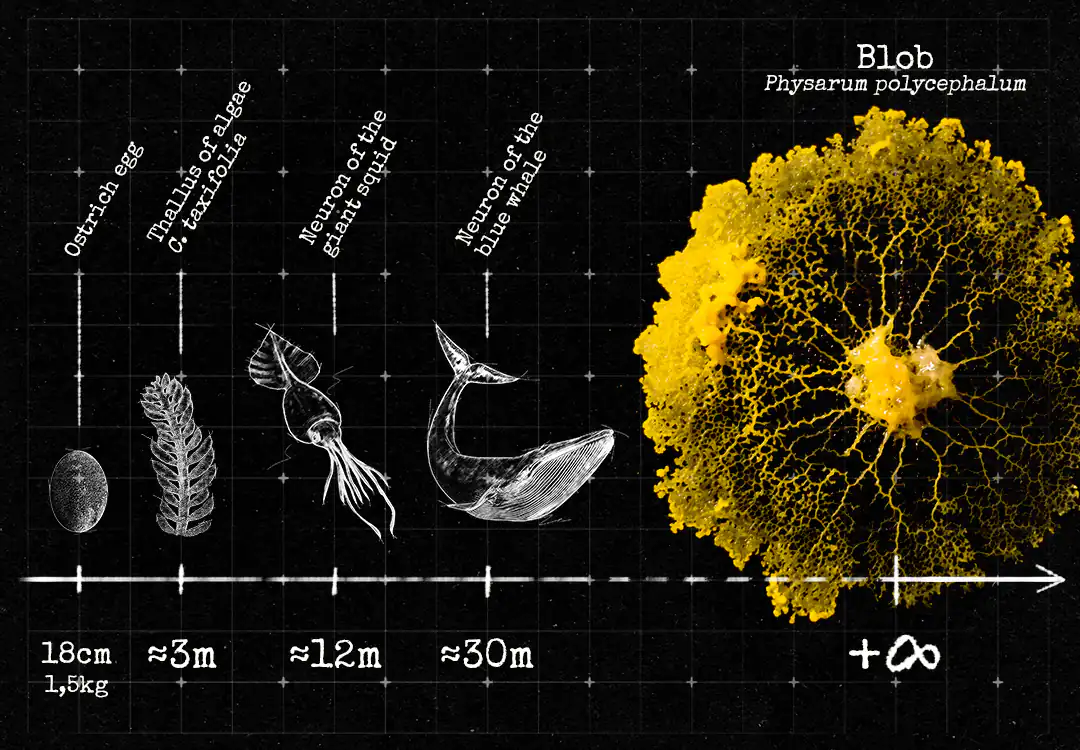
🏅 Blob-Records
Quick quiz: one of these records may be fake. Can you guess which one?
- In the lab: 10 m² (University of Bonn, Germany)
- At school: 53 m long (Châteauroux High School, France)
- In nature: 1.3 km² (Appalachian Mountains, USA)?
✅ Answer
No. 1… and, to some extent, No. 3.
Two records often cited by biologist Audrey Dussutour, but which need to be tempered: The famous blob at the University of Bonn? Reported to be 10 m², the archives actually mention 5.54 m² (12) – which is still an impressive feat.
As for the “ Appalachian giant,” the figures are correct… except that they were fragments of the same individual scattered over 1.3 km² (13). No shocking photos: the monster we imagined belongs to the legend of Mytho-mycetes.
In the end, the only perfectly related record is that of 2021 at the Châteauroux High School (14)… headed by Dussutour herself. It seems the best way to describe a record accurately is to set it for yourself.
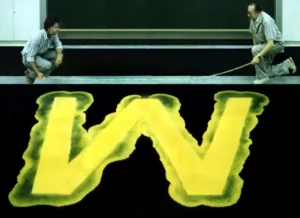 📷 Photo left (F. Achenbach): Professor Karl-Ernst Wohlfarth-Bottermann (right) – German pioneer of blob research – poses with a giant 5.54 m² blob, cultivated in his honor at the Institute for Cytology in Bonn. A tribute officially recorded in the 1989 Guinness Book of Records
📷 Photo left (F. Achenbach): Professor Karl-Ernst Wohlfarth-Bottermann (right) – German pioneer of blob research – poses with a giant 5.54 m² blob, cultivated in his honor at the Institute for Cytology in Bonn. A tribute officially recorded in the 1989 Guinness Book of Records
Phase 3
Earth Jaws
Which mouth will eat us? When it comes to blobs, no matter how hard you look… there is none.
Their lethal weapon? Phagocytosis (15).
A blob preying on bacteria. To spare you the violence of these images, we have recreated the scene using agave syrup, turmeric, and fennel seeds.
With no jaws or teeth, the blob engulfs its prey to extract the precious molecules on its surface: proteins, lipids, carbohydrates.
It slowly wraps itself around these nutrients to form a small digestive chamber. There, it releases its enzymes – thousands of tiny biological scissors – which methodically cut the large molecules into assimilable fragments (16).
The nutrients are absorbed. The waste is expelled.
Silently.
But this calm is not harmless.
All over its surface, new sites of phagocytosis can be activated in parallel, as long as the blob has enough enzymes and energy (ATP) in reserve. Like an army of tiny invisible pincers, it scrapes its environment, crumb by crumb. A slow, methodical – and relentless – operation.
In the wild, it is nicknamed “the cleaner.”
Although it never consumes its prey entirely – merely nibbling at the outside – it leaves behind a translucent veil of mucus, saturated with organic waste (16).
In forests, this carpet will nourish plants.
An almost generous gesture… if it weren’t the remnant of a creeping appetite.
What if your dear carcass… met the same fate?
After all, it may not be a coincidence that « death » metal takes on the appearance of a myxomycete.
Final phase
The Hunger Game

May the odds be ever in your flavor.

Aside from screenwriters, biologists are fairly confident about this.
The blob lives in an ecosystem, not in a blockbuster movie.
Its development is channeled by the availability of its prey (fungi, bacteria, protists, plant debris), but also by its predators.
Slugs love it, mites nibble on it (17), and some beetles occasionally bite it (18). Thus, the food chain keeps it under control (so far).
And then, without moisture, it falls asleep. Too much light? It retreats. Not great for a major invasion.
Still, keep a watchful eye on this critter: because if you had to fight back against a blob attack, katana in hand, I bet you’d never guess what it’s capable of…
In the next episode
The Resilience of the Hydra
An ancient monster in a Petri dish!
📚 References
- Kamiya, N. (1950) — The rate of the protoplasmic flow in the myxomycete plasmodium I. Cytologia 15(3): 183–193. DOI : 10.1508/cytologia.15.183
- Nakamura, A. & Kohama, K. (1999) — Calcium regulation of the actin-myosin interaction of Physarum polycephalum. International Review of Cytology 191: 53–98. DOI : 10.1016/S0074-7696(08)60157-6
- Kohama, K. & Kendrick-Jones, J. (1986) — The inhibitory Ca²⁺-regulation of the actin-activated Mg-ATPase activity of myosin from Physarum polycephalum plasmodia. Journal of Biochemistry 99(5): 1433–1446. DOI : 10.1093/oxfordjournals.jbchem.a135613
- Alim, K., Amselem, G., Peaudecerf, F., Brenner, M. P. & Pringle, A. (2013) — Random network peristalsis in Physarum polycephalum organizes fluid flows across an individual. Proceedings of the National Academy of Sciences USA 110(33): 13306–13311. DOI : 10.1073/pnas.1305049110
- Saiseau, R., Busson, V. & Durand, M. (2025) — Slow modulation of the contraction patterns in Physarum polycephalum. arXiv preprint. DOI : 10.48550/arXiv.2501.02651
- Govindarajan, D. K., Meghanathan, Y., Sivaramakrishnan, M., et al. (2022) — Enterococcus faecalis thrives in dual-species biofilm models under iron-rich conditions. Archives of Microbiology 204: 710. DOI : 10.1007/s00203-022-03309-7
- IUCN (2024) — Global invasive species database: Physarum polycephalum. International Union for Conservation of Nature. URL : https://www.iucngisd.org/gisd/species.php?sc=115&utm
- Smith, D. H. (2009) — Stretch growth of integrated axon tracts: extremes and exploitations. Progress in Neurobiology 89(3): 231–239. DOI : 10.1016/j.pneurobio.2009.07.006
- Muséum de Toulouse Métropole (2024) — Insolite : ni champignon, ni plante, ni animal, ni bactérie, simplement BLOB ! Muséum de Toulouse. URL : https://museum.toulouse-metropole.fr/insolite-ni-champignon-ni-plante-ni-animal-ni-bacterie-simplement-blob/
- Schliwa, M. (1997) — In Memoriam: Karl-Ernst Wohlfarth-Bottermann (1923–1997). European Journal of Protistology 33: 452–459.
- Stephenson, S. L., Clark, J. & Landolt, J. C. (2004) — Myxomycetes occurring as single genetic strains in forest soils. Systematics and Geography of Plants 74(2): 287–289.
- CNRS (2022) — Record du blob le plus long du monde au lycée. CNRS Images. URL : https://images.cnrs.fr/photo/20220072_0001
- Mayne, R., Patton, D., de Lacy Costello, B., Adamatzky, A. & Patton, R. C. (2011) — On the internalisation, intraplasmodial carriage and excretion of metallic nanoparticles in the slime mould, Physarum polycephalum. International Journal of Nanotechnology and Molecular Computation 3(3): 1–14. DOI : 10.4018/ijnmc.2011070101
- Wolf, K. V. & Stockem, W. (1979) — Studies on microplasmodia of Physarum polycephalum: Endocytotic activity, morphology of the vacuolar apparatus and defecation mechanism. Protoplasma 99: 125–138. DOI : 10.1007/BF01274074
- Michalczyk-Wetula, D., Jakubowska, M., Felska, M., et al. (2021) — Tyrophagus putrescentiae (Sarcoptiformes: Acaridae) in the in vitro cultures of slime molds (Mycetozoa): accident, contamination, or interaction? Experimental and Applied Acarology 84: 445–458. DOI : 10.1007/s10493-021-00608-4
- Sugiura, S., Fukasawa, Y., Ogawa, R., Kawakami, S.-I. & Yamazaki, K. (2019) — Beetles as potential dispersers of slime mold spores. Bulletin of the Ecological Society of America 100(3): e01564. DOI : 10.1002/bes2.1564
Cover image created by Christophe Gouix
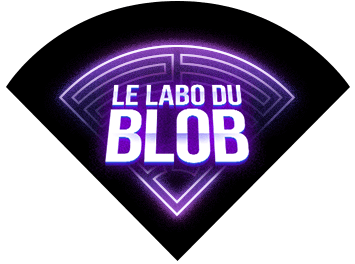

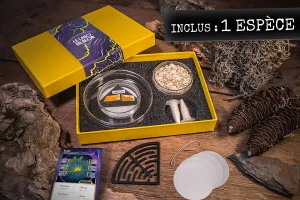
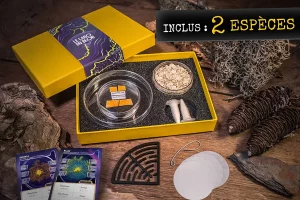
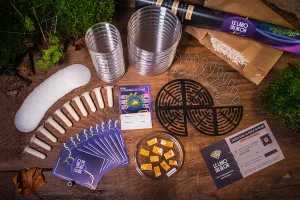
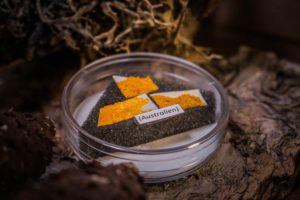


0 Comments